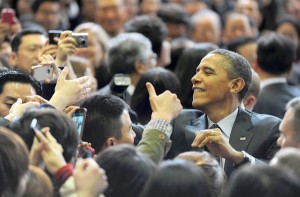
President Obama greets attendes after delivering remarks during a visit to Hankuk University of Foreign Studies in Seoul on March 26, 2012. (Image Source: LA Times)
By Daryl G. Kimball On Monday President Barack Obama delivered a major address on his nuclear security agenda at Hankuk University in Seoul as he and other leaders gather for the second international Nuclear Security Summit. The bulk of his remarks focused on the progress made to secure nuclear weapons usable materials, but he also provided a status report on his broader nuclear risk reduction agenda three years after his stirring April 2009 speech in Prague, and the implementation of new presidential guidance on U.S. nuclear weapons strategy. On the role of U.S. nuclear weapons in the post-Cold War, post-9/11 era, Obama said that "the massive nuclear arsenal we inherited from the Cold War is poorly suited for today's threats, including nuclear terrorism ... we have more nuclear weapons than we need." He's right. Obama spelled out his reasoning in a personal and common sense manner: American leadership has been essential to progress in a second area—taking concrete steps toward a world without nuclear weapons. As a party to the Nuclear Nonproliferation Treaty, this is our obligation, and it's one I take very seriously. But I believe the United States has a unique responsibility to act—indeed, a moral obligation. I say this as President of the only nation ever to use nuclear weapons. I say it as a Commander in Chief who knows that our nuclear codes are never far from my side. And I say it as a father, who wants my two young daughters to grow up in a world where everything they know and love can't be wiped out in a horrible instant. Obama noted the progress achieved with the 2010 U.S.-Russian New START agreement and he said: As President, I changed our nuclear posture to reduce the number and role of nuclear weapons in our national security strategy. I made it clear that the United States will not develop new nuclear warheads. We will not pursue new military missions for nuclear weapons. We've narrowed the range of contingencies under which we would ever use or threaten to use nuclear weapons. At the same time, I've made it clear that so long as nuclear weapons exist, we'll work with our Congress to maintain a safe, secure and effective arsenal that guarantees the defense of the United States and our allies—including South Korea and Japan. And he noted: My Administration's nuclear posture recognizes that the massive nuclear arsenal we inherited from the Cold War is poorly suited for today's threats, including nuclear terrorism. Last summer, I therefore directed my national security team to conduct a comprehensive study of our nuclear forces. That study is still underway. But even as we have more work to do, we can already say with confidence that we have more nuclear weapons than we need. Even after New START, the United States will still have more than 1,500 deployed nuclear weapons, and some 5,000 warheads. I firmly believe that we can ensure the security of the United States and our allies, maintain a strong deterrent against any threat, and still pursue further reductions in our nuclear arsenal. Indeed. Further, deep reductions in bloated U.S. and Russian nuclear forces are in order. A look at the world's other nuclear-armed states shows that other than Russia, China is the only other potential nuclear adversary that can launch nuclear weapons against the U.S. homeland and it possesses just 40 to 50 warheads on intercontinental-range missiles. Now is the time for the President to translate his words into concrete action. Obama can and should implement a significant reduction of the overall U.S. nuclear stockpile—to 1,000 deployed and nondeployed warheads or fewer—in the coming years. As the 2007 Arms Control Association report "What Are Nuclear Weapons For?" by physicist Sidney Drell and former negotiator James Goodby suggests, the United States can deter any potential aggressor by moving to a smaller force of 500 deployed and 500 nondeployed strategic warheads on a much smaller, mainly submarine-based triad. This would still provide more than sufficient firepower to deter nuclear attack by any current or future adversary. To make the necessary changes in the old nuclear war plan, Obama should eliminate outdated targeting assumptions developed decades ago to deplete an opponent's war-fighting assets after the outbreak of hostilities rather than to ensure there is a sufficient retaliatory capability to deter nuclear attack in the first place. He should also seek to lower current requirements for how much damage must be accomplished to ensure that a target is destroyed. To deter a nuclear attack, adversaries need only realize the United States is capable of reducing key targets to radioactive rubble rather than a fine dust. These changes in U.S. nuclear strategy would open the way for lower U.S.-Russian force levels, either through a new treaty or reciprocal and parallel cuts and would enhance prospects for mutual, verifiable nuclear reductions involving other nuclear-armed states--and bring the peace and security of a world without nuclear weapons closer to reality.
